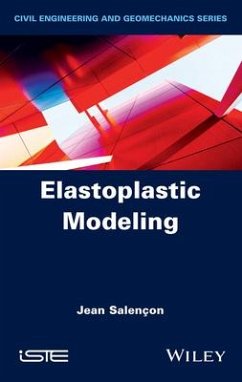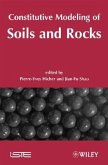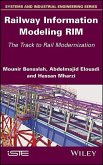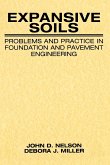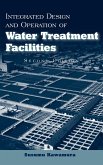Jean Salencon
Elastoplastic Modeling
Jean Salencon
Elastoplastic Modeling
- Gebundenes Buch
- Merkliste
- Auf die Merkliste
- Bewerten Bewerten
- Teilen
- Produkt teilen
- Produkterinnerung
- Produkterinnerung
Elastoplastic behavior has long been part of the constitutive models incorporated in most computer codes, used in the design of civil and mechanical engineering structures. Elastoplastic Modeling offers a compact presentation of the fundamentals of classical elastoplastic modeling, the basis for many engineering applications currently implemented. This book provides a general background to enhance understanding of the modeling assumptions that govern the rationales of these applications. With this understanding comes the ability to assess their validation range and propose possible…mehr
Andere Kunden interessierten sich auch für
![Constitutive Modeling of Soils and Rocks Constitutive Modeling of Soils and Rocks]() Constitutive Modeling of Soils and Rocks302,99 €
Constitutive Modeling of Soils and Rocks302,99 €![Railway Information Modeling Rim Railway Information Modeling Rim]() Mounir BensalahRailway Information Modeling Rim170,99 €
Mounir BensalahRailway Information Modeling Rim170,99 €![Geotechnical Correlations for Soils and Rocks Geotechnical Correlations for Soils and Rocks]() Jean-Claude VerbruggeGeotechnical Correlations for Soils and Rocks177,99 €
Jean-Claude VerbruggeGeotechnical Correlations for Soils and Rocks177,99 €![Expansive Soils Expansive Soils]() John NelsonExpansive Soils167,99 €
John NelsonExpansive Soils167,99 €![Integrated Design and Operation of Water Treatment Facilities Integrated Design and Operation of Water Treatment Facilities]() Susumu KawamuraIntegrated Design and Operation of Water Treatment Facilities207,99 €
Susumu KawamuraIntegrated Design and Operation of Water Treatment Facilities207,99 €![International Construction International Construction]() Mark MawhinneyInternational Construction108,99 €
Mark MawhinneyInternational Construction108,99 €![Railway Rolling Stock (Railtex) Railway Rolling Stock (Railtex)]() Pep (Professional Engineering Publishers)Railway Rolling Stock (Railtex)333,99 €
Pep (Professional Engineering Publishers)Railway Rolling Stock (Railtex)333,99 €-
-
-
Elastoplastic behavior has long been part of the constitutive models incorporated in most computer codes, used in the design of civil and mechanical engineering structures. Elastoplastic Modeling offers a compact presentation of the fundamentals of classical elastoplastic modeling, the basis for many engineering applications currently implemented. This book provides a general background to enhance understanding of the modeling assumptions that govern the rationales of these applications. With this understanding comes the ability to assess their validation range and propose possible improvements. An instructive approach replaces excessive mathematical developments with a semi-phenomenological method, where mathematical modeling is driven by - and derived from - experimental observations. A logical track is followed, starting from material behavior modeling and leading to the analysis of the anelastic response of systems, subjected to quasi-static loading processes.
Hinweis: Dieser Artikel kann nur an eine deutsche Lieferadresse ausgeliefert werden.
Hinweis: Dieser Artikel kann nur an eine deutsche Lieferadresse ausgeliefert werden.
Produktdetails
- Produktdetails
- Verlag: Wiley
- Seitenzahl: 272
- Erscheinungstermin: 13. Oktober 2020
- Englisch
- Abmessung: 241mm x 155mm x 20mm
- Gewicht: 544g
- ISBN-13: 9781786306234
- ISBN-10: 1786306239
- Artikelnr.: 59947103
- Herstellerkennzeichnung
- Libri GmbH
- Europaallee 1
- 36244 Bad Hersfeld
- gpsr@libri.de
- Verlag: Wiley
- Seitenzahl: 272
- Erscheinungstermin: 13. Oktober 2020
- Englisch
- Abmessung: 241mm x 155mm x 20mm
- Gewicht: 544g
- ISBN-13: 9781786306234
- ISBN-10: 1786306239
- Artikelnr.: 59947103
- Herstellerkennzeichnung
- Libri GmbH
- Europaallee 1
- 36244 Bad Hersfeld
- gpsr@libri.de
Jean Salençon is a Member of the French Academy of Sciences, the French Academy of Technologies, and Academia Europaea. He is also an Honorary/Foreign Member of the Academies of Hungary, Milan and Lisbon. He is also Senior Fellow of the Hong Kong Institute for Advanced Study (HKIAS). His research interests include continuum mechanics, structural analysis and soil mechanics.
Preface xi
Notations xiii
Introduction xxv
Chapter 1. Elastic Domains: Yield Conditions 1
1.1. Introductory remarks 1
1.2. An overview of the model 4
1.2.1. The infinitesimal transformation framework 4
1.2.2. Time variable 4
1.3. One-dimensional approach 5
1.3.1. Uniaxial tension test 5
1.3.2. Uniaxial tension-compression test 8
1.3.3. The Bauschinger effect 9
1.3.4. Other one-dimensional experiments 10
1.4. Multidimensional approach 11
1.4.1. A multidimensional experiment 11
1.4.2. Initial elastic domain 12
1.4.3. Work-hardening 13
1.4.4. Perfectly plastic material 14
1.4.5. Bui's experimental results 14
1.5. Yield conditions 16
1.5.1. Initial yield condition and yield function 16
1.5.2. Loading function and work-hardening 18
1.5.3. Simple work-hardening models 19
1.6. Yield criteria and loading functions 22
1.6.1. Convexity 22
1.6.2. Isotropy 23
1.6.3. The Tresca yield criterion 24
1.6.4. The von Mises yield criterion 27
1.6.5. Other yield criteria for metals 30
1.6.6. Yield criteria for anisotropic materials 31
1.6.7. Yield criteria for granular materials 35
1.7. Final comments 41
Chapter 2. The Plastic Flow Rule 43
2.1. One-dimensional approach 43
2.1.1. Work-hardening material 43
2.1.2. Perfectly plastic material 45
2.2. Multidimensional approach for a work-hardening material 46
2.2.1. Loading and unloading processes 46
2.2.2. General properties of the plastic flow rule 49
2.2.3. Plastic potential: associated plasticity 51
2.2.4. Principle of maximum plastic work 54
2.2.5. Validation of the principle of maximum plastic work 55
2.2.6. Piecewise continuously differentiable loading functions 57
2.3. Multidimensional approach for a perfectly plastic material 59
2.3.1. Loading and unloading processes 59
2.3.2. Application of the principle of maximum plastic work 61
2.3.3. Drucker's postulate 62
2.4. Plastic dissipation 64
2.4.1. Plastic dissipation per unit volume 64
2.4.2. Plastic dissipation and support function of the elastic domain 64
2.4.3. Plastic velocity jumps in the case of perfectly plastic materials 65
2.5. Generalized standard materials 66
2.6. Mises', Tresca's and Coulomb's perfectly plastic standard materials 69
2.6.1. Mises' perfectly plastic standard material 69
2.6.2. Tresca's perfectly plastic standard material 71
2.6.3. Coulomb's perfectly plastic standard material 72
2.6.4. About edge and vertex regimes 74
Chapter 3. Elastoplastic Modeling in Generalized Variables 77
3.1. About generalized variables 77
3.2. Elastic domains 78
3.2.1. Initial elastic domain 78
3.2.2. Work-hardening and perfect plasticity 79
3.3. The anelastic flow rule 80
3.3.1. Anelasticity or plasticity? 80
3.3.2. Principle of maximum work 81
3.3.3. The work-hardening anelastic flow rule 82
3.3.4. The "perfectly plastic" anelastic flow rule 83
3.3.5. Anelastic dissipation 84
3.4. Generalized continua 84
3.4.1. Curvilinear generalized continuum 84
3.4.2. Planar generalized continuum 90
Chapter 4. Quasi-static Elastoplastic Processes 101
4.1. Quasi-static loading processes 101
4.1.1. Mechanical evolution within the SPH framework 101
4.1.2. Quasi-static loading process within the SPH framework 104
4.1.3. Statically admissible and kinematically admissible fields 104
4.1.4. Parametric problems 105
4.2. Quasi-static elastoplastic loading processes 108
4.2.1. Problematics 108
4.2.2. Existence and uniqueness theorems 111
4.2.3. Uniqueness theorems for stress rates and strain rates 115
4.3. Response of a system made from an elastic and standard perfectly
plastic material 116
4.3.1. Initial elastic domain of the system 116
4.3.2. Existence of the solution to the elastoplastic evolution problem 118
4.3.3. Solution to the elastoplastic evolution problem 119
4.3.4. Limit loads for the system 120
4.3.5. Linear elastic response of the system 121
4.3.6. Anelastic response of the system 122
4.3.7. Taking geometry changes into account 136
4.4. Response of a system made from a standard work-hardening elastoplastic
material 139
4.4.1. Initial elastic domain of the system 139
4.4.2. Residual stress rates, residual strain rates 140
4.4.3. Maximum work theorem 140
4.4.4. Summing up... 141
Chapter 5. Quasi-static Elastoplastic Processes: Minimum Principles 143
5.1. Elastic and standard perfectly plastic constituent material 143
5.1.1. Minimum principle for the stress rate field 143
5.1.2. Minimum principle for the velocity field 146
5.1.3. Other expressions of the minimum principles 152
5.2. Elastic and standard positive work-hardening constituent material 153
5.2.1. Revisiting the constitutive equation 153
5.2.2. Minimum principle for the stress rate field 155
5.2.3. Minimum principle for the velocity field 156
5.2.4. Other expressions of the minimum principles 158
5.2.5. Historical comments 158
5.3. Minimum principles for the stress and strain fields 159
5.3.1. Colonnetti's theorem 159
5.3.2. Other expressions of Colonnetti's minimum principles 160
Chapter 6. Limit Loads: Limit Analysis 161
6.1. Limit loads and yield design (1) 161
6.2. Static approach, first plastic collapse theorem 163
6.2.1. Safe loads, interior approach 163
6.2.2. Lower bound theorem 164
6.3. Kinematic approach, second plastic collapse theorem 165
6.3.1. Plastically admissible velocity fields 165
6.3.2. Kinematic necessary condition to be satisfied by safe loads 167
6.3.3. Exterior approach, upper bound theorem 169
6.4. Combining static and kinematic approaches 170
6.4.1. Determination of a limit load 170
6.4.2. Association theorem 172
6.4.3. Duality 173
6.5. Limit analysis and the rigid, perfectly plastic material concept 173
6.5.1. Rigid and standard perfectly plastic model 173
6.5.2. The connection with limit loads 174
6.6. Limit loads and yield design (2) 176
6.6.1. Fundamentals of the yield design theory 176
6.6.2. Resistance of the constituent material 177
6.6.3. Potentially safe loads, interior approach and lower bound theorem
178
6.6.4. Maximum resisting rate of work, exterior approach and upper bound
theorem 178
6.6.5. Matching limit load and yield design theories 181
6.7. Two-dimensional limit analysis 182
6.7.1. Plane strain limit analysis problems 182
6.7.2. Partial static solutions to plane strain limit analysis problems 183
6.7.3. Complete static solutions to plane strain limit analysis problems
183
6.7.4. Complete kinematic solutions to plane strain limit analysis problems
184
6.7.5. "Incomplete" solutions to plane strain limit analysis problems 188
6.7.6. Complete solutions to plane strain limit analysis problems 189
6.7.7. Comments 192
6.7.8. Plane stress limit analysis 194
6.7.9. Axially symmetric problems 196
6.8. Implementation 200
6.8.1. Analytical solutions 200
6.8.2. Analytical/numerical solutions 202
6.8.3. Numerical solutions 203
6.8.4. The example of a tantalizing problem 204
6.8.5. Final comments 208
References 211
Index 231
Notations xiii
Introduction xxv
Chapter 1. Elastic Domains: Yield Conditions 1
1.1. Introductory remarks 1
1.2. An overview of the model 4
1.2.1. The infinitesimal transformation framework 4
1.2.2. Time variable 4
1.3. One-dimensional approach 5
1.3.1. Uniaxial tension test 5
1.3.2. Uniaxial tension-compression test 8
1.3.3. The Bauschinger effect 9
1.3.4. Other one-dimensional experiments 10
1.4. Multidimensional approach 11
1.4.1. A multidimensional experiment 11
1.4.2. Initial elastic domain 12
1.4.3. Work-hardening 13
1.4.4. Perfectly plastic material 14
1.4.5. Bui's experimental results 14
1.5. Yield conditions 16
1.5.1. Initial yield condition and yield function 16
1.5.2. Loading function and work-hardening 18
1.5.3. Simple work-hardening models 19
1.6. Yield criteria and loading functions 22
1.6.1. Convexity 22
1.6.2. Isotropy 23
1.6.3. The Tresca yield criterion 24
1.6.4. The von Mises yield criterion 27
1.6.5. Other yield criteria for metals 30
1.6.6. Yield criteria for anisotropic materials 31
1.6.7. Yield criteria for granular materials 35
1.7. Final comments 41
Chapter 2. The Plastic Flow Rule 43
2.1. One-dimensional approach 43
2.1.1. Work-hardening material 43
2.1.2. Perfectly plastic material 45
2.2. Multidimensional approach for a work-hardening material 46
2.2.1. Loading and unloading processes 46
2.2.2. General properties of the plastic flow rule 49
2.2.3. Plastic potential: associated plasticity 51
2.2.4. Principle of maximum plastic work 54
2.2.5. Validation of the principle of maximum plastic work 55
2.2.6. Piecewise continuously differentiable loading functions 57
2.3. Multidimensional approach for a perfectly plastic material 59
2.3.1. Loading and unloading processes 59
2.3.2. Application of the principle of maximum plastic work 61
2.3.3. Drucker's postulate 62
2.4. Plastic dissipation 64
2.4.1. Plastic dissipation per unit volume 64
2.4.2. Plastic dissipation and support function of the elastic domain 64
2.4.3. Plastic velocity jumps in the case of perfectly plastic materials 65
2.5. Generalized standard materials 66
2.6. Mises', Tresca's and Coulomb's perfectly plastic standard materials 69
2.6.1. Mises' perfectly plastic standard material 69
2.6.2. Tresca's perfectly plastic standard material 71
2.6.3. Coulomb's perfectly plastic standard material 72
2.6.4. About edge and vertex regimes 74
Chapter 3. Elastoplastic Modeling in Generalized Variables 77
3.1. About generalized variables 77
3.2. Elastic domains 78
3.2.1. Initial elastic domain 78
3.2.2. Work-hardening and perfect plasticity 79
3.3. The anelastic flow rule 80
3.3.1. Anelasticity or plasticity? 80
3.3.2. Principle of maximum work 81
3.3.3. The work-hardening anelastic flow rule 82
3.3.4. The "perfectly plastic" anelastic flow rule 83
3.3.5. Anelastic dissipation 84
3.4. Generalized continua 84
3.4.1. Curvilinear generalized continuum 84
3.4.2. Planar generalized continuum 90
Chapter 4. Quasi-static Elastoplastic Processes 101
4.1. Quasi-static loading processes 101
4.1.1. Mechanical evolution within the SPH framework 101
4.1.2. Quasi-static loading process within the SPH framework 104
4.1.3. Statically admissible and kinematically admissible fields 104
4.1.4. Parametric problems 105
4.2. Quasi-static elastoplastic loading processes 108
4.2.1. Problematics 108
4.2.2. Existence and uniqueness theorems 111
4.2.3. Uniqueness theorems for stress rates and strain rates 115
4.3. Response of a system made from an elastic and standard perfectly
plastic material 116
4.3.1. Initial elastic domain of the system 116
4.3.2. Existence of the solution to the elastoplastic evolution problem 118
4.3.3. Solution to the elastoplastic evolution problem 119
4.3.4. Limit loads for the system 120
4.3.5. Linear elastic response of the system 121
4.3.6. Anelastic response of the system 122
4.3.7. Taking geometry changes into account 136
4.4. Response of a system made from a standard work-hardening elastoplastic
material 139
4.4.1. Initial elastic domain of the system 139
4.4.2. Residual stress rates, residual strain rates 140
4.4.3. Maximum work theorem 140
4.4.4. Summing up... 141
Chapter 5. Quasi-static Elastoplastic Processes: Minimum Principles 143
5.1. Elastic and standard perfectly plastic constituent material 143
5.1.1. Minimum principle for the stress rate field 143
5.1.2. Minimum principle for the velocity field 146
5.1.3. Other expressions of the minimum principles 152
5.2. Elastic and standard positive work-hardening constituent material 153
5.2.1. Revisiting the constitutive equation 153
5.2.2. Minimum principle for the stress rate field 155
5.2.3. Minimum principle for the velocity field 156
5.2.4. Other expressions of the minimum principles 158
5.2.5. Historical comments 158
5.3. Minimum principles for the stress and strain fields 159
5.3.1. Colonnetti's theorem 159
5.3.2. Other expressions of Colonnetti's minimum principles 160
Chapter 6. Limit Loads: Limit Analysis 161
6.1. Limit loads and yield design (1) 161
6.2. Static approach, first plastic collapse theorem 163
6.2.1. Safe loads, interior approach 163
6.2.2. Lower bound theorem 164
6.3. Kinematic approach, second plastic collapse theorem 165
6.3.1. Plastically admissible velocity fields 165
6.3.2. Kinematic necessary condition to be satisfied by safe loads 167
6.3.3. Exterior approach, upper bound theorem 169
6.4. Combining static and kinematic approaches 170
6.4.1. Determination of a limit load 170
6.4.2. Association theorem 172
6.4.3. Duality 173
6.5. Limit analysis and the rigid, perfectly plastic material concept 173
6.5.1. Rigid and standard perfectly plastic model 173
6.5.2. The connection with limit loads 174
6.6. Limit loads and yield design (2) 176
6.6.1. Fundamentals of the yield design theory 176
6.6.2. Resistance of the constituent material 177
6.6.3. Potentially safe loads, interior approach and lower bound theorem
178
6.6.4. Maximum resisting rate of work, exterior approach and upper bound
theorem 178
6.6.5. Matching limit load and yield design theories 181
6.7. Two-dimensional limit analysis 182
6.7.1. Plane strain limit analysis problems 182
6.7.2. Partial static solutions to plane strain limit analysis problems 183
6.7.3. Complete static solutions to plane strain limit analysis problems
183
6.7.4. Complete kinematic solutions to plane strain limit analysis problems
184
6.7.5. "Incomplete" solutions to plane strain limit analysis problems 188
6.7.6. Complete solutions to plane strain limit analysis problems 189
6.7.7. Comments 192
6.7.8. Plane stress limit analysis 194
6.7.9. Axially symmetric problems 196
6.8. Implementation 200
6.8.1. Analytical solutions 200
6.8.2. Analytical/numerical solutions 202
6.8.3. Numerical solutions 203
6.8.4. The example of a tantalizing problem 204
6.8.5. Final comments 208
References 211
Index 231
Preface xi
Notations xiii
Introduction xxv
Chapter 1. Elastic Domains: Yield Conditions 1
1.1. Introductory remarks 1
1.2. An overview of the model 4
1.2.1. The infinitesimal transformation framework 4
1.2.2. Time variable 4
1.3. One-dimensional approach 5
1.3.1. Uniaxial tension test 5
1.3.2. Uniaxial tension-compression test 8
1.3.3. The Bauschinger effect 9
1.3.4. Other one-dimensional experiments 10
1.4. Multidimensional approach 11
1.4.1. A multidimensional experiment 11
1.4.2. Initial elastic domain 12
1.4.3. Work-hardening 13
1.4.4. Perfectly plastic material 14
1.4.5. Bui's experimental results 14
1.5. Yield conditions 16
1.5.1. Initial yield condition and yield function 16
1.5.2. Loading function and work-hardening 18
1.5.3. Simple work-hardening models 19
1.6. Yield criteria and loading functions 22
1.6.1. Convexity 22
1.6.2. Isotropy 23
1.6.3. The Tresca yield criterion 24
1.6.4. The von Mises yield criterion 27
1.6.5. Other yield criteria for metals 30
1.6.6. Yield criteria for anisotropic materials 31
1.6.7. Yield criteria for granular materials 35
1.7. Final comments 41
Chapter 2. The Plastic Flow Rule 43
2.1. One-dimensional approach 43
2.1.1. Work-hardening material 43
2.1.2. Perfectly plastic material 45
2.2. Multidimensional approach for a work-hardening material 46
2.2.1. Loading and unloading processes 46
2.2.2. General properties of the plastic flow rule 49
2.2.3. Plastic potential: associated plasticity 51
2.2.4. Principle of maximum plastic work 54
2.2.5. Validation of the principle of maximum plastic work 55
2.2.6. Piecewise continuously differentiable loading functions 57
2.3. Multidimensional approach for a perfectly plastic material 59
2.3.1. Loading and unloading processes 59
2.3.2. Application of the principle of maximum plastic work 61
2.3.3. Drucker's postulate 62
2.4. Plastic dissipation 64
2.4.1. Plastic dissipation per unit volume 64
2.4.2. Plastic dissipation and support function of the elastic domain 64
2.4.3. Plastic velocity jumps in the case of perfectly plastic materials 65
2.5. Generalized standard materials 66
2.6. Mises', Tresca's and Coulomb's perfectly plastic standard materials 69
2.6.1. Mises' perfectly plastic standard material 69
2.6.2. Tresca's perfectly plastic standard material 71
2.6.3. Coulomb's perfectly plastic standard material 72
2.6.4. About edge and vertex regimes 74
Chapter 3. Elastoplastic Modeling in Generalized Variables 77
3.1. About generalized variables 77
3.2. Elastic domains 78
3.2.1. Initial elastic domain 78
3.2.2. Work-hardening and perfect plasticity 79
3.3. The anelastic flow rule 80
3.3.1. Anelasticity or plasticity? 80
3.3.2. Principle of maximum work 81
3.3.3. The work-hardening anelastic flow rule 82
3.3.4. The "perfectly plastic" anelastic flow rule 83
3.3.5. Anelastic dissipation 84
3.4. Generalized continua 84
3.4.1. Curvilinear generalized continuum 84
3.4.2. Planar generalized continuum 90
Chapter 4. Quasi-static Elastoplastic Processes 101
4.1. Quasi-static loading processes 101
4.1.1. Mechanical evolution within the SPH framework 101
4.1.2. Quasi-static loading process within the SPH framework 104
4.1.3. Statically admissible and kinematically admissible fields 104
4.1.4. Parametric problems 105
4.2. Quasi-static elastoplastic loading processes 108
4.2.1. Problematics 108
4.2.2. Existence and uniqueness theorems 111
4.2.3. Uniqueness theorems for stress rates and strain rates 115
4.3. Response of a system made from an elastic and standard perfectly
plastic material 116
4.3.1. Initial elastic domain of the system 116
4.3.2. Existence of the solution to the elastoplastic evolution problem 118
4.3.3. Solution to the elastoplastic evolution problem 119
4.3.4. Limit loads for the system 120
4.3.5. Linear elastic response of the system 121
4.3.6. Anelastic response of the system 122
4.3.7. Taking geometry changes into account 136
4.4. Response of a system made from a standard work-hardening elastoplastic
material 139
4.4.1. Initial elastic domain of the system 139
4.4.2. Residual stress rates, residual strain rates 140
4.4.3. Maximum work theorem 140
4.4.4. Summing up... 141
Chapter 5. Quasi-static Elastoplastic Processes: Minimum Principles 143
5.1. Elastic and standard perfectly plastic constituent material 143
5.1.1. Minimum principle for the stress rate field 143
5.1.2. Minimum principle for the velocity field 146
5.1.3. Other expressions of the minimum principles 152
5.2. Elastic and standard positive work-hardening constituent material 153
5.2.1. Revisiting the constitutive equation 153
5.2.2. Minimum principle for the stress rate field 155
5.2.3. Minimum principle for the velocity field 156
5.2.4. Other expressions of the minimum principles 158
5.2.5. Historical comments 158
5.3. Minimum principles for the stress and strain fields 159
5.3.1. Colonnetti's theorem 159
5.3.2. Other expressions of Colonnetti's minimum principles 160
Chapter 6. Limit Loads: Limit Analysis 161
6.1. Limit loads and yield design (1) 161
6.2. Static approach, first plastic collapse theorem 163
6.2.1. Safe loads, interior approach 163
6.2.2. Lower bound theorem 164
6.3. Kinematic approach, second plastic collapse theorem 165
6.3.1. Plastically admissible velocity fields 165
6.3.2. Kinematic necessary condition to be satisfied by safe loads 167
6.3.3. Exterior approach, upper bound theorem 169
6.4. Combining static and kinematic approaches 170
6.4.1. Determination of a limit load 170
6.4.2. Association theorem 172
6.4.3. Duality 173
6.5. Limit analysis and the rigid, perfectly plastic material concept 173
6.5.1. Rigid and standard perfectly plastic model 173
6.5.2. The connection with limit loads 174
6.6. Limit loads and yield design (2) 176
6.6.1. Fundamentals of the yield design theory 176
6.6.2. Resistance of the constituent material 177
6.6.3. Potentially safe loads, interior approach and lower bound theorem
178
6.6.4. Maximum resisting rate of work, exterior approach and upper bound
theorem 178
6.6.5. Matching limit load and yield design theories 181
6.7. Two-dimensional limit analysis 182
6.7.1. Plane strain limit analysis problems 182
6.7.2. Partial static solutions to plane strain limit analysis problems 183
6.7.3. Complete static solutions to plane strain limit analysis problems
183
6.7.4. Complete kinematic solutions to plane strain limit analysis problems
184
6.7.5. "Incomplete" solutions to plane strain limit analysis problems 188
6.7.6. Complete solutions to plane strain limit analysis problems 189
6.7.7. Comments 192
6.7.8. Plane stress limit analysis 194
6.7.9. Axially symmetric problems 196
6.8. Implementation 200
6.8.1. Analytical solutions 200
6.8.2. Analytical/numerical solutions 202
6.8.3. Numerical solutions 203
6.8.4. The example of a tantalizing problem 204
6.8.5. Final comments 208
References 211
Index 231
Notations xiii
Introduction xxv
Chapter 1. Elastic Domains: Yield Conditions 1
1.1. Introductory remarks 1
1.2. An overview of the model 4
1.2.1. The infinitesimal transformation framework 4
1.2.2. Time variable 4
1.3. One-dimensional approach 5
1.3.1. Uniaxial tension test 5
1.3.2. Uniaxial tension-compression test 8
1.3.3. The Bauschinger effect 9
1.3.4. Other one-dimensional experiments 10
1.4. Multidimensional approach 11
1.4.1. A multidimensional experiment 11
1.4.2. Initial elastic domain 12
1.4.3. Work-hardening 13
1.4.4. Perfectly plastic material 14
1.4.5. Bui's experimental results 14
1.5. Yield conditions 16
1.5.1. Initial yield condition and yield function 16
1.5.2. Loading function and work-hardening 18
1.5.3. Simple work-hardening models 19
1.6. Yield criteria and loading functions 22
1.6.1. Convexity 22
1.6.2. Isotropy 23
1.6.3. The Tresca yield criterion 24
1.6.4. The von Mises yield criterion 27
1.6.5. Other yield criteria for metals 30
1.6.6. Yield criteria for anisotropic materials 31
1.6.7. Yield criteria for granular materials 35
1.7. Final comments 41
Chapter 2. The Plastic Flow Rule 43
2.1. One-dimensional approach 43
2.1.1. Work-hardening material 43
2.1.2. Perfectly plastic material 45
2.2. Multidimensional approach for a work-hardening material 46
2.2.1. Loading and unloading processes 46
2.2.2. General properties of the plastic flow rule 49
2.2.3. Plastic potential: associated plasticity 51
2.2.4. Principle of maximum plastic work 54
2.2.5. Validation of the principle of maximum plastic work 55
2.2.6. Piecewise continuously differentiable loading functions 57
2.3. Multidimensional approach for a perfectly plastic material 59
2.3.1. Loading and unloading processes 59
2.3.2. Application of the principle of maximum plastic work 61
2.3.3. Drucker's postulate 62
2.4. Plastic dissipation 64
2.4.1. Plastic dissipation per unit volume 64
2.4.2. Plastic dissipation and support function of the elastic domain 64
2.4.3. Plastic velocity jumps in the case of perfectly plastic materials 65
2.5. Generalized standard materials 66
2.6. Mises', Tresca's and Coulomb's perfectly plastic standard materials 69
2.6.1. Mises' perfectly plastic standard material 69
2.6.2. Tresca's perfectly plastic standard material 71
2.6.3. Coulomb's perfectly plastic standard material 72
2.6.4. About edge and vertex regimes 74
Chapter 3. Elastoplastic Modeling in Generalized Variables 77
3.1. About generalized variables 77
3.2. Elastic domains 78
3.2.1. Initial elastic domain 78
3.2.2. Work-hardening and perfect plasticity 79
3.3. The anelastic flow rule 80
3.3.1. Anelasticity or plasticity? 80
3.3.2. Principle of maximum work 81
3.3.3. The work-hardening anelastic flow rule 82
3.3.4. The "perfectly plastic" anelastic flow rule 83
3.3.5. Anelastic dissipation 84
3.4. Generalized continua 84
3.4.1. Curvilinear generalized continuum 84
3.4.2. Planar generalized continuum 90
Chapter 4. Quasi-static Elastoplastic Processes 101
4.1. Quasi-static loading processes 101
4.1.1. Mechanical evolution within the SPH framework 101
4.1.2. Quasi-static loading process within the SPH framework 104
4.1.3. Statically admissible and kinematically admissible fields 104
4.1.4. Parametric problems 105
4.2. Quasi-static elastoplastic loading processes 108
4.2.1. Problematics 108
4.2.2. Existence and uniqueness theorems 111
4.2.3. Uniqueness theorems for stress rates and strain rates 115
4.3. Response of a system made from an elastic and standard perfectly
plastic material 116
4.3.1. Initial elastic domain of the system 116
4.3.2. Existence of the solution to the elastoplastic evolution problem 118
4.3.3. Solution to the elastoplastic evolution problem 119
4.3.4. Limit loads for the system 120
4.3.5. Linear elastic response of the system 121
4.3.6. Anelastic response of the system 122
4.3.7. Taking geometry changes into account 136
4.4. Response of a system made from a standard work-hardening elastoplastic
material 139
4.4.1. Initial elastic domain of the system 139
4.4.2. Residual stress rates, residual strain rates 140
4.4.3. Maximum work theorem 140
4.4.4. Summing up... 141
Chapter 5. Quasi-static Elastoplastic Processes: Minimum Principles 143
5.1. Elastic and standard perfectly plastic constituent material 143
5.1.1. Minimum principle for the stress rate field 143
5.1.2. Minimum principle for the velocity field 146
5.1.3. Other expressions of the minimum principles 152
5.2. Elastic and standard positive work-hardening constituent material 153
5.2.1. Revisiting the constitutive equation 153
5.2.2. Minimum principle for the stress rate field 155
5.2.3. Minimum principle for the velocity field 156
5.2.4. Other expressions of the minimum principles 158
5.2.5. Historical comments 158
5.3. Minimum principles for the stress and strain fields 159
5.3.1. Colonnetti's theorem 159
5.3.2. Other expressions of Colonnetti's minimum principles 160
Chapter 6. Limit Loads: Limit Analysis 161
6.1. Limit loads and yield design (1) 161
6.2. Static approach, first plastic collapse theorem 163
6.2.1. Safe loads, interior approach 163
6.2.2. Lower bound theorem 164
6.3. Kinematic approach, second plastic collapse theorem 165
6.3.1. Plastically admissible velocity fields 165
6.3.2. Kinematic necessary condition to be satisfied by safe loads 167
6.3.3. Exterior approach, upper bound theorem 169
6.4. Combining static and kinematic approaches 170
6.4.1. Determination of a limit load 170
6.4.2. Association theorem 172
6.4.3. Duality 173
6.5. Limit analysis and the rigid, perfectly plastic material concept 173
6.5.1. Rigid and standard perfectly plastic model 173
6.5.2. The connection with limit loads 174
6.6. Limit loads and yield design (2) 176
6.6.1. Fundamentals of the yield design theory 176
6.6.2. Resistance of the constituent material 177
6.6.3. Potentially safe loads, interior approach and lower bound theorem
178
6.6.4. Maximum resisting rate of work, exterior approach and upper bound
theorem 178
6.6.5. Matching limit load and yield design theories 181
6.7. Two-dimensional limit analysis 182
6.7.1. Plane strain limit analysis problems 182
6.7.2. Partial static solutions to plane strain limit analysis problems 183
6.7.3. Complete static solutions to plane strain limit analysis problems
183
6.7.4. Complete kinematic solutions to plane strain limit analysis problems
184
6.7.5. "Incomplete" solutions to plane strain limit analysis problems 188
6.7.6. Complete solutions to plane strain limit analysis problems 189
6.7.7. Comments 192
6.7.8. Plane stress limit analysis 194
6.7.9. Axially symmetric problems 196
6.8. Implementation 200
6.8.1. Analytical solutions 200
6.8.2. Analytical/numerical solutions 202
6.8.3. Numerical solutions 203
6.8.4. The example of a tantalizing problem 204
6.8.5. Final comments 208
References 211
Index 231

